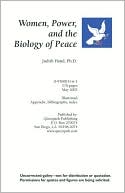

 |

|

The average rating for Women, Power, and the Biology of Peace based on 2 reviews is 4 stars.
Review # 1 was written on 2017-12-01 00:00:00 Kurt Berlin Kurt BerlinThis book has an impossibly broad scope for a trim title, but I was eager to learn about the biological differences between men and women in primates and how applications of physiology in social contexts can create gendered divides in behavior. Also included in this book is speculation on matrilocal societies of old, implications of female empowerment in modern societies, and Dr. Hand even finds time to take Fukuyama to task for his exclusion of 'half of all humanity' in his writings. Throughout the book the author also references countless other texts on feminism, sociology, peaceology, and more, so this book can be seen as a sort of living bibliography. Fascinating book, a quick read, and I can't stop talking to my friends about what I learned reading it. |
Review # 2 was written on 2018-01-23 00:00:00 Tracy Dalglish Tracy DalglishPoland: A New Power in Transatlantic Security is a compendium of a series of essays outlining Poland's role in NATO, the resulting impact on EUs security initiatives, and the state's aspirations towards the status of a major regional power. The essays focus on the state of affairs leading up to 2002, and as such serve solely as a historical insight into the existing geopolitical situation in Europe. Nonetheless, this work offers valuable background information for those relatively unfamiliar with the subject, while raising interesting questions that can be gleefully answered by those that are rather familiar with the existing situation in the region >8) Poland's rise to the status of a major power has been rapid. Merely 10 years after the banishment of the communist rule in 1989, Poland ascended to the ranks of NATO after series of gruelling reforms and much political wrangling. The conditions of admission into NATO required significant reforms of Poland's military establishment. From her communist predecessors, the state inherited an officer-laden army of 300,000, which has been primarily developed to act as a defensive force. NATO, on the other hand, requires its members to field highly mobile, offensive forces that can be deployed rapidly to respond to crises beyond national borders, and posses capability to interoperate with other NATO units. This requirement forced changes in training, reductions in numbers, reorganization of the rank-and-file as well as supporting bureaucracy, financial reforms, and modernization of aging soviet-era equipment ... a task that Poland embarked upon with determination and eventual success. The first test came in the form of Balkan operations during the Kosovo Conflict. By all accounts, Poland earned very high marks, and has earned trust of members, and raised expectations. Furthermore, Poland asserted herself as a leader in Eastern Europe, and has successfully acted as a NATO ambassador to the nations beyond NATO's eastern borders. However, some potential issues and concerns were noted. Poland's desire to join NATO has been heavily driven by the need of protection from the perceived Russian threat. Even after the fall of communism in that country, Russia continued to assert its control by military means (in places like Chechnya, for instance), and by economic means (by controlling the flow and cost of natural resources, among other measures). Developments in Russia and her aggressive stance towards her former satellites had influenced Polish policy and orientation towards a more defensive military development, despite encouragement of NATO otherwise. Furthermore, Poland had sought NATO almost exclusively in favor of the United States, believing that only that country could be relied upon as a security provider. Poland pursued and championed the involvement of NATO, and US in particular, in European security initiatives. This book notes that Poland's strong atlanticist policies put her in conflict with European states that promoted a framework, namely the European Security and Defence Policy (ESDP), which aimed to limit American influence on the continent. This conflict culminated after the book had been published with the invasion of Iraq, which Poland joined to the detriment of European powers such Germany, and especially France, a staunch proponent of ESDP. However, despite various conflicts of higher and lesser importance, Poland had been growing in influence on the regional and world stages. Today, as a member of both the European Union and NATO, Poland continues to reform its military establishment, and continues to develop as a security provider, rather than consumer. On the reform front, a long-running conscription system has been finally abolished -- one of the concerns mentioned in this title -- and the army is now completely volunteer-based. Further reforms reduced the standing army to the targeted 100,000, with another 20,000 trained reserves, placing it inline with other professional forces. Equipment modernization continues unabated, and Poland is one of only few NATO members that maintain the agreed upon military spending levels at 2% of GDP. Poland is also engaged in a number of operations throughout the world. If geopolitics tickle your fancy, I recommend that you check out George Friedman's The Next Decade: What the World Will Look Like and The Next 100 Years: A Forecast for the 21st Century. In his books, Friedman strives to predict future developments based on his studies of the world's current geopolitical reality. Prominent in his predictions is the rise of Poland as a major power. |
CAN'T FIND WHAT YOU'RE LOOKING FOR? CLICK HERE!!!